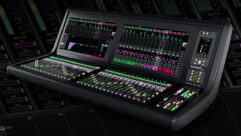

Measuring Signal-to-Noise Ratios Ain’t Easy
pieces of the commissioning puzzle. We soon realized the error of our ways.
Over the past year, I have been involved with the Electronic Audio Noise Measurement Task Group of the Project Commissioning Working Group hosted by InfoComm. The goal has been to develop a best practice for measuring signal-to-noise ratios that a field technician could easily perform and come up with a pass/fail grade.
We originally thought this would be a relatively simple process, one of the “easy” pieces of the commissioning puzzle to place. We soon realized the error of our ways and began to see just how connected this measurement piece was to other parts of the process.
The questions that we had to address rushed over us: Do we take into account acoustic noise? How would you measure it? Who should measure it? Who should fix any problems, should they be found? Who tells the mechanical contractor his system needs adjustment? How do you determine other acoustical and electronic noise sources in the room or the system? How are those sources identified and corrected? Does it really make sense to measure electronic noise levels without first adjusting system gain? What method should be used to adjust system gain? Do you bring the system to the same level throughout, as you would in a broadcast or recording environment? Or do bring everything to clip at the same time, as you might in a live sound reinforcement system? Does any of this even make any sense in the digital age, where electronic noise is, for all intents and purposes (at least in some minds), non-existent?
Nuts? Or Just Dedicated?
When you stand back and look at all these issues, trying to sort them out and make sense of what lies before you, you come to the realization that you’re either nuts and you enjoy this form of self-flagellation-or you care deeply about the industry and where it is headed. I’m not patting myself on the back here, as I waiver between both extremes, even on my best days. My son is fond of quoting George Bernard Shaw: “The reasonable man adapts himself to the world; the unreasonable man persists in trying to adapt the world to himself. Therefore all progress depends on the unreasonable man.”
The genesis of the entire project lay in the desire to show that we’ve matured beyond the chromium cochlea and gilt retina crowd of basement experimentalists and Radio Shack do-it-yourselfers. We’re now a bona fide industry that knows how to define, design, install, and verify that a system works as it was originally intended and that it precisely meets the needs of the end-user.
Our efforts also have roots in the recording and broadcast industries. I’m sure many of you remember the test cards at which we aimed our cameras prior to air to make sure the video and audio signals would be within industry “standards” and FCC guidelines-that the tubes had not drifted, that color would be accurate, and that audio signals would be clear and undistorted.
With the improved stability and quality of modern electronics, those cards have been replaced by modern audio and video test signal generators. Setting up and aligning a quad- or multitrack tape recorder has evolved into a process of making sure we’re not overloading the input preamps of the modern hard disk-based recording system while also ensuring the highest possible dynamic range, and signal-to-noise ratio, in line with the flattest possible frequency response. In short, we are doing our best to provide the optimal experience for listener or viewer by bringing our gear into proper alignment.
Notice I said “evolved.” We can’t completely rid ourselves of the need for standards, or for comparing our systems against an ideal or norm. Regardless of the tools we use, we still measure; we still hold up our work against an ideal. It’s a task we perform continuously (or should perform, just like backing up important data on a computer).
And we do this on a number of levels, not just with our technology and the solutions we build. We are constantly making adjustments in every aspect of our lives-personal, professional, financial-and at every level of our business, society, and government.
Sometimes adjustments can be painful, especially when we realize how far out of alignment we were-how far we’d strayed from the ideal. Adjustments can come from the recognition that our lives, our work, and our relationships (business and otherwise) don’t match the standard we would typically compare ourselves against. Adjustments could also be necessary due to changes in the standards that evolve around us.
Just as we on the InfoComm task force found out how interrelated our efforts were in defining a means of measuring electronic noise, we can see how every aspect of our lives and our industry are interrelated. As much as we might like to compartmentalize things, we always confront the reality that our personal lives impact our professional lives and vice versa. There’s a dynamic that is constantly at work when we try to bring all of those aspects of our lives into balance.
Alignment in the face of challenge
My hope is that in the coming year, just as we commit to implementing better audiovisual and control systems, we also commit to reviewing our lives more often than just on New Year’s Day. The coming months may prove especially challenging for our industry, and business as a whole.
I hope we do what it takes, which will sometimes require difficult decisions, to ensure our lives are aligned with our goals and desires. It will mean being unreasonable with ourselves in order to look honestly at who we are, what we are doing, and how we are succeeding in accomplishing our goals, whether in business or at home.
We should also remember how interconnected we are; that decisions in one area often have consequences in others. We can’t afford to compartmentalize our lives, pretending that home does not affect work or the other way around. Remember what we learn from the integrated audiovisual systems we build; there is a corollary in each of our lives.
At the same time we’re unreasonable with ourselves, we should be gracious and humble towards one another, spurring ourselves to perform “good works,” even as we line up that next job, commission that new system, and position our AV businesses for future success. Nietzsche said, “The essential thing ‘in heaven and earth’ is that there should be a long obedience in the same direction; there thereby results, and has always resulted in the long run, something which has made life worth living.”
While a friend of mine once said that any day you have to quote Nietzsche is a bad day, Friedrich could always be counted on for a couple nice thoughts to speed us on our way.
Have a great year!
Thom Mullins is a senior consultant with BRC Acoustics & Technology Consulting in Seattle.










